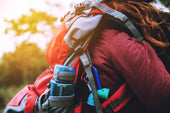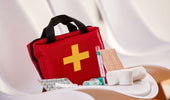Our world is increasingly determined by unusual climate events, geopolitical conflicts, and the growing tendency to return to a simpler lifestyle. Survivalism and off-the-grid living have become very popular.
Rather than a movement countering modern societies’ shortcomings, these ideas manifest people’s sense of freedom, mindfulness, and desire to live in harmony with nature.
Amidst this setting, an innovative field emerges at the crossroads of cutting-edge science and age-old survival skills: Survival BioTech.

Survival Biotech bears the light of hope and amazes the world by introducing innovative concepts with the knowledge of traditional survival techniques and the magic touched by modern biotechnology.
It becomes a marriage that emphasizes self-sufficiency and environmental conservation, as well as adapting communities to the variability of global conditions, such as disasters or events challenging our sustenance and quality of life.
THIS ARTICLE uncovers the scope of Survival Biotech, which may be a game-changer in food production, healthcare, clean energy, sustainability, and numerous other domains.
We will now explore Survival Biotech, how genetic innovations, the advantages of synthetic biology, and bioremediation processes can all be reliable allies in surviving and living an unconventional life.
The Essence of Survival Biotech
Survival Biotech blends the world of biotechnology and survivalism, focusing on:
-
Innovation in Biotechnology: Leveraging genetic engineering, synthetic biology, and more to enhance self-sufficiency.
-
Survival Skills Enhancement: Integrating modern scientific achievements with traditional survival techniques.
The Role of Biotechnology in Survival
Biotechnology serves as a crucial tool in overcoming the challenges of off-grid living, including:
-
Food Security: Developing resilient crop varieties that can thrive in adverse conditions.
-
Healthcare Improvements: Enhancing disease detection and treatment through portable diagnostic tools.
-
Energy Sustainability: Innovating in bioenergy to provide renewable energy sources.
The Potential Impact of Survival Biotech
The fusion of biotechnology and survival skills holds the promise to:
-
Revolutionize Food Production
Genetic engineering, such as CRISPR, can make crops more nutritious and resilient.
-
Enhance Health and Safety
Portable DNA sequencers can monitor pathogens, improving human health and food safety.
-
Sustain Energy Needs
Bioenergy solutions convert waste to electricity, reducing countries' dependence on traditional power sources.
Pioneering Food Production through Genetic Innovation
Survival Biotech is set to revolutionize how we produce food, leveraging genetic innovations like CRISPR technology to enhance crop resilience and nutritional value.

CRISPR and Crop Enhancement
Exploring the potential of CRISPR technology reveals groundbreaking opportunities to enhance crop production and offer solutions to global food security challenges.
-
Innovative Genetic Tool: CRISPR (Clustered Regularly Interspaced Short Palindromic Repeats) allows precise editing of DNA, offering unprecedented control over organisms' genetic makeup.
-
Implications for Agriculture: Scientists can edit crop genomes to enhance resilience, yield, and nutritional value, addressing current and future food security challenges.
Case Studies of Genetically Revised Crops:
-
Drought-Resistant Cassava in Africa: Scientists have utilized CRISPR to develop cassava plants that thrive in dry conditions, offering hope to regions facing water scarcity.
-
Nutrient-Enhanced Rice in Asia: Genetic editing has produced rice varieties with improved yields and nutritional content, targeting food security and nutritional deficiencies.
Benefits and Ethical Considerations
Addressing genetically enhanced crops' benefits and ethical considerations is crucial to understanding their role in sustainable agriculture and societal acceptance.
Environmental and Health Benefits:
-
Reduced Agricultural Impact: Genetically edited crops can lessen the need for water, pesticides, and fertilizers, minimizing agriculture's environmental footprint.
-
Healthier Food Options: Enhanced nutritional profiles of crops contribute to better health outcomes for consumers.
-
Pest-Resistant Cotton in India: This innovation has reduced pesticide use and increased the income of smallholder farmers.
Addressing Ethical Concerns
-
Safety and Accessibility: Ensuring that genetically edited crops are safe and accessible to all, not just those in developed nations.
-
Regulatory Systems: Developing comprehensive regulations that balance innovation with ethical considerations, environmental protection, and public health.
Ensuring Health and Safety with Portable DNA Sequencers
Portable DNA sequencers are revolutionizing health and safety protocols in off-grid living. They provide essential tools for real-time diagnostics and environmental monitoring.
This section explores how these compact, versatile devices are integrated into survival strategies, enhancing our ability to detect pathogens and ensure food safety.

Technology Overview and Applications
Portable DNA sequencing technologies bring laboratory-grade diagnostics directly to off-grid environments, offering unprecedented pathogen detection and biodiversity assessment capabilities.
-
Compact and Accessible
Portable DNA sequencers have made genomic analysis accessible outside traditional lab settings, allowing on-site, real-time testing.
-
Versatile Uses
These devices can identify water, soil, and food pathogens and monitor environmental biodiversity, offering various applications from healthcare to agriculture.
Examples of Application in Off-Grid Living:
-
Pathogen Detection: Rapid identification of bacteria and viruses in drinking water or crops, enhancing preventive healthcare measures.
-
Environmental Monitoring: Assessing soil health and water quality to guide sustainable farming and living practices.
-
Case Study - Amazon Rainforest: Researchers have used portable DNA sequencers to rapidly identify infectious diseases, improving indigenous populations' health outcomes.
Impact on Survival Strategies
Incorporating real-time diagnostics into survival strategies significantly enhances the capacity to prevent disease and ensure food safety, which are critical aspects of off-grid living.
Role of Real-Time Diagnostics:
-
Preventing Disease: Immediate identification and management of health threats reduce the risk of outbreaks and the spread of infectious diseases.
-
Ensuring Food Safety: Verifying the safety of harvested crops and hunted or gathered food ensures nutritional integrity and prevents foodborne illnesses.
Integration into Off-Grid Living Practices:
-
Self-Sufficiency in Healthcare: Empowering individuals and communities to conduct health and environmental assessments, reducing dependency on external healthcare systems.
-
Community Health Initiatives: Portable sequencers can be part of community health monitoring programs, fostering a collective approach to disease prevention and environmental stewardship.
-
Ebola Outbreak in West Africa: The deployment of portable sequencers helped swiftly contain the viral spread, highlighting the importance of real-time diagnostics.
Illuminating the Dark: Bioluminescent Lighting Solutions
Bioluminescent lighting solutions offer a sustainable and enchanting alternative to traditional lighting methods. They harness the power of nature to illuminate off-grid environments.
This section delves into how bioluminescence, found in various natural organisms, is engineered for practical and eco-friendly applications in off-grid living.
Bioluminescence in Nature
Discovering the magic and mechanics behind nature's lighting system, bioluminescence, provides insights into sustainable light sources.
Understanding Bioluminescence:
-
Natural Phenomenon
Bioluminescence is a natural process in which living organisms produce light through chemical reactions within their bodies. It is observed in various species, including fireflies, certain fungi, and marine organisms.
-
Inspiration for Innovation
The natural world's ability to generate light efficiently and sustainably inspires scientists to mimic these processes, aiming for eco-friendly lighting solutions.
Engineering Bioluminescent Systems
Exploring the genetic engineering behind bioluminescent systems opens up new possibilities for renewable lighting solutions.
Discussing Genetic Engineering of Lighting Solutions:
-
Biotechnological Advances
Understanding the genetic makeup that allows certain organisms to emit light allows researchers to engineer plants or microbial systems to produce bioluminescent light, which offers a renewable illumination source.
-
Applications in Off-Grid Living
Engineered bioluminescent plants or microbes could serve as sustainable lighting sources, reducing the need for electric or battery-powered lights.
Applications and Benefits
Applying bioluminescent systems in off-grid living showcases their potential to revolutionize our approach to sustainable lighting.
The table below summarizes the key points regarding bioluminescent lighting in off-grid living situations, highlighting its practical applications and environmental benefits.
Aspect
Potential Uses in Off-Grid Living Environments
Environmental Advantages of Natural Lighting Solutions
Sustainable Illumination
Bioluminescent lighting provides a low-impact, renewable source of light, ideal for off-grid homes, buildings, and communities seeking to minimize their environmental footprint.
Reducing energy consumption by utilizing living organisms for lighting significantly lowers energy usage.
Innovative Aesthetics
Beyond practicality and efficiency, bioluminescent solutions offer unique aesthetic possibilities for living spaces, blending the boundaries between technology, design, and nature.
Bioluminescent solutions foster a deeper connection with the natural world and encourage a lifestyle that respects and integrates with the environment.
Crafting Materials and Medicines through Synthetic Biology
Synthetic biology represents a frontier in biotech. It combines the precision of engineering with the complexity of biology to innovate in healthcare and material science.
This section examines how synthetic biology is used to craft highly demanded materials and medicines and enhance off-grid living through localized production.

The Power of Synthetic Biology
Synthetic biology stands at the confluence of several scientific disciplines, offering transformative potential for producing materials and medicines.
Introduction to Synthetic Biology:
-
Defining Synthetic Biology
It is a cutting-edge field that combines biotechnology, genetic engineering, and molecular biology to redesign organisms for specific tasks, including producing medicines, chemicals, and materials.
-
Expanding Possibilities
By programming cells to perform novel functions, synthetic biology opens up new avenues for producing virtually anything, from biofuels to biodegradable plastics, more sustainably and cost-effectively.
Bioproduction of Essential Goods
The bioproduction of essential goods showcases the practical application of synthetic biology in creating medicines and materials critical for off-grid living.
Examples of Materials and Medicines Produced:
-
Medicines
Engineering yeast and bacteria to produce pharmaceuticals allows for the localized manufacturing of essential drugs, reduces costs, and improves access in remote areas.
-
Materials
Producing biodegradable materials and biofabrics, offering an environmentally friendly alternative to traditional plastics and textiles.
Transforming Off-Grid Living
Synthetic biology's on-site production capacity radically transforms off-grid communities' self-sufficiency and sustainability.
How On-Site Production Enhances Self-Sufficiency:
-
Reduced Dependence
The ability to produce essential goods on-site drastically reduces reliance on external supply chains and infrastructure, which is crucial for remote or off-grid living situations.
-
Sustainability and Resilience
Localized production methods are more sustainable and ensure communities are less vulnerable to global supply chain disruptions.
Empowering Communities:
-
Innovation in Education and Skills
Adopting synthetic biology requires and fosters a deep understanding of biological processes, encouraging educational advancements and skill development in communities.
-
Collaborative Projects
Community labs and maker spaces can serve as hubs for innovation. They allow individuals to collaborate on synthetic biology projects, fostering a culture of creativity and shared learning.
Restoring Environments with Bioremediation
Bioremediation is a powerful tool in Survival Biotech's arsenal, offering a path to restore and rejuvenate compromised environments.
This section delves into the techniques and applications of bioremediation, highlighting its pivotal role in promoting soil health, ecological balance, and, ultimately, the sustainability of off-grid living.
Bioremediation Techniques
Understanding bioremediation techniques is fundamental in appreciating how microorganisms can be leveraged to cleanse the environment of pollutants.
Overview of Bioremediation:
-
Natural Process Enhancement
Bioremediation involves using living organisms like bacteria, fungi, and plants to detoxify polluted environments. It effectively enhances natural processes that break down harmful substances.
-
Versatility and Application
This technique can address various contaminants, from oil spills to heavy metals in soil, making it a versatile tool for environmental restoration.
Application in Soil Restoration
The application of bioremediation in soil restoration showcases its ability to recover fertile grounds and promote sustainable agriculture.
Success Stories of Soil Health Recovery:
-
Reviving Agricultural Land
Case studies of bioremediation successfully restore the fertility of soils previously deemed unusable due to contamination, thus reviving agricultural productivity.
-
Implications for Sustainable Agriculture
Healthy soil is the foundation of sustainable agriculture. Bioremediation cleanses the soil and improves its structure and nutrient content, enhancing crop yields and reducing the need for chemical fertilizers.
Contribution to Survival and Sustainability
Bioremediation's contribution to survival and sustainability emphasizes its critical role in ensuring a healthy environment for future generations.
The Role of Bioremediation in Ensuring Long-term Survival:
-
Ecological Balance
By restoring contaminated land and water sources, bioremediation plays a crucial role in maintaining ecological balance and ensuring the availability of clean resources for future generations.
-
Adaptability and Resilience
Improved soil health enhances biodiversity and makes ecosystems more resilient to climate change, pests, and diseases.
Enhancing Off-Grid Living:
-
Self-Sustaining Practices
Incorporating bioremediation into off-grid living practices creates self-sustaining environments where reliance on external resources is minimized.
-
Community Engagement
Community-driven bioremediation projects can foster a sense of stewardship and collective responsibility towards the local environment, enhancing social cohesion and resilience.
Generating Energy from Waste: Bioenergy Solutions
Transforming waste into energy presents a sustainable and innovative solution for off-grid communities. It leverages the untapped potential of organic materials.
This section explores bioenergy technologies, their applications in off-grid settings, and how they enhance energy independence and environmental health.

Bioenergy Technologies Overview
Delving into bioenergy technologies offers insights into how organic waste can be repurposed into a valuable energy resource.
Explanation of Microbial Fuel Cells and Other Bioenergy Systems:
-
Microbial Fuel Cells (MFCs)
MFCs use bacteria to break down organic matter, converting chemical energy directly into electrical energy. This process offers a promising approach to generating power from various types of organic waste.
-
Broad Application Spectrum
Beyond MFCs, bioenergy technologies encompass anaerobic digestion, bioethanol production, and biogas generation, offering unique advantages for converting waste into energy.
Waste to Energy in Off-Grid Settings
The practical bioenergy applications in off-grid settings illustrate how waste can become a cornerstone of sustainable energy strategies in other countries.
Practical Applications and Benefits
-
Sustainable Waste Management
Converting agricultural residues, household waste, and other organic materials into energy reduces reliance on landfill disposal, mitigates methane emissions, and contributes to environmental health.
-
Reliable Energy Source
Bioenergy systems can provide a consistent, renewable energy supply for off-grid communities, which is essential for lighting, heating, and powering essential devices.
Enhancing Energy Independence
Bioenergy is pivotal in reducing dependence on traditional power sources, underscoring its importance for resilience and sustainability.
The Importance of Bioenergy for Reducing Reliance on Traditional Power Sources
-
Promoting Resilience
Bioenergy solutions generate energy by utilizing locally available resources. They enhance the autonomy and resilience of off-grid communities and reduce their vulnerability to external energy supply disruptions.
-
Environmental and Economic Benefits
Bioenergy contributes to a lower carbon footprint and offers potential economic advantages. It transforms waste into a valuable energy resource, supporting local economies and sustainable development policies.
Navigating Challenges and Ethical Considerations
As the field of Survival Biotech advances, it encounters a spectrum of challenges and ethical considerations that must be addressed to ensure its positive impact on society.
This section explores the technical, financial, and ethical hurdles, alongside the importance of community engagement and regulatory oversight in successfully implementing Survival Biotech solutions.

Technical and Financial Barriers
Identifying and overcoming technical and financial barriers is crucial for the practical application of Survival Biotech in off-grid and survival scenarios.
-
Technical Adaptability and Climate Resilience
Research is intensifying to create biotech solutions that are climate-resilient and adaptable to a range of environmental stresses, from high salinity in soils to extreme temperatures. This involves leveraging genetic diversity from wild crop relatives to engineer more robust and adaptable food sources.
-
Scaling Financial Models for Accessibility
Innovators are exploring new financial models, such as microfinancing and public-private partnerships, to make biotech solutions more accessible to off-grid and marginalized communities. These various funding models aim to reduce the economic barriers to adoption, ensuring cutting-edge technologies can benefit those who stand to benefit most.
Ethical and Societal Implications
Ethical considerations are at the heart of Survival Biotech, necessitating a careful balance between technological advancement and societal values.
-
Preserving Cultural Integrity and Biodiversity
As biotech solutions are developed and deployed, a critical balance must be struck between technological advancement and preserving cultural heritage and biodiversity.
This includes ethical considerations regarding introducing genetically modified organisms (GMOs) into environments with endemic species, ensuring that these interventions do not disrupt local ecological and cultural systems.
-
Participatory Design and Consent
There is an increasing emphasis on participatory design processes, where local communities are not just consulted but actively involved in creating and tailoring biotech solutions to their specific circumstances.
This approach ensures that projects are grounded in local consent and ownership, fostering a sense of empowerment and ensuring that technologies are used in ways that align with local values and needs.
-
Transparency and Governance
The ethical deployment of Survival Biotech necessitates transparent governance mechanisms that clearly outline the responsibilities of all stakeholders, from researchers and developers to local communities and governments.
Establishing clear guidelines and accountability measures is essential for navigating potential risks and ensuring that the benefits of biotech innovations are shared equitably.
-
Long-term Environmental Monitoring
With the introduction of biotech solutions into ecosystems, long-term monitoring programs are critical to assess and mitigate any unforeseen impacts on environmental health and biodiversity.
Such programs should be designed to adaptively manage biotech interventions, ensuring they contribute positively to ecological balance and sustainability.
The Importance of Community Engagement and Regulatory Oversight
Fostering an inclusive approach through community engagement and robust regulatory frameworks is vital for the ethical deployment of Survival Biotech.
Building Trust and Developing Guidelines:
-
Building Trust
Engaging with communities to understand their needs and concerns can build trust and ensure that Survival Biotech solutions are aligned with local values and priorities.
-
Developing Guidelines
Comprehensive regulatory frameworks are crucial to ensuring the safe development and application of Survival Biotech, balancing innovation with ethical considerations and public safety.
Embracing the Future with Survival Biotech
Diving into Survival Biotech's new arena, we realize that this field could solve many of today's critical problems.
From improved food security and healthcare to energy sustainability and environmental stewardship, Survival Biotech presents a promising path toward a future where humans can better harmonize with the environment.
Adopting modern biotechnological innovations along with the skills of traditional survival tactics strengthens resiliency and autonomy. It also catalyzes the new phase of our struggle for environmental balance.
Key Takeaways:
-
Revolutionizing Food Production: Genetic innovations like CRISPR in agriculture practically demonstrate how to improve the productivity of more resistant and nutrition-rich crops, addressing food security problems.
-
Advancing Healthcare: Pocketable DNA sequencers can be a game-changer in the health and safety working environment, offering the opportunity of handheld instruments for fast analysis and environmental monitoring.
-
Sustainable Energy Solutions: Biomass energy technology is one sustainable power option that converts waste into energy and improves energy independence by reducing power consumption from other sources.
-
Environmental Restoration: Survival Biotech demonstrates its capability to repair and regain polluted ecosystems using methods like bioremediation and a constructed bioluminescent system. Thus, it can use more environmentally friendly approaches to replace destructive practices.

Navigating Challenges and Ethical Considerations:
The road ahead involves many efforts addressing technical, financial, and ethical issues. Avoiding the misuse of biotech solutions, maintaining cultural integrity and biodiversity, and engaging communities in participatory designs are indispensable ethical steps for such technologies.
One key role will be transparent governance and long-term environmental monitoring, which will help ensure that Survival Biotech's benefits are not temporary but equitable and sustainable.
Researchers, policy-makers, and communities must collaborate, especially during technological innovation, versus preserving tradition.
Through ongoing research to explore the ins and outs of Survival Biotech, continuous community engagement, and support for its assimilation into people's lives, whether in survival conditions or those off the grid, the community can enjoy the advantages of this amazing technology.
We can make the future evolve to be resilient, autonomous, and self-sustaining if we are united. We shall then make Survival Biotech's vision and core pursuits manifest.
Let us welcome the new chapter opened by Survival Biotech and embark on a journey where nature and technology live in harmony and resilience, sustainability, and stewardship are prioritized.





















































